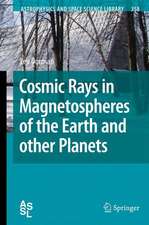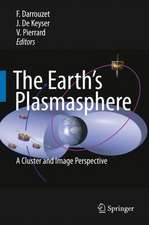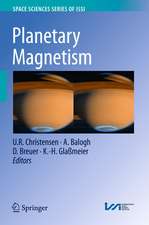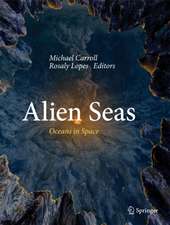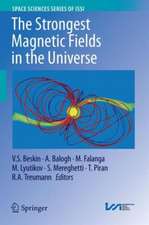Making Starships and Stargates: The Science of Interstellar Transport and Absurdly Benign Wormholes: Springer Praxis Books
Autor James F. Woodwarden Limba Engleză Paperback – 14 dec 2012
There may now be a way to achieve these lofty objectives. “Making Starships and Stargates” will have three parts. The first will deal with information about the theories of relativity needed to understand the predictions of the effects that make possible the “propulsion” techniques, and an explanation of those techniques. The second will deal with experimental investigations into the feasibility of the predicted effects; that is, do the effects exist and can they be applied to propulsion? The third part of the book – the most speculative – will examine the question: what physics is needed if weare to make wormholes and warp drives? Is such physics plausible? And how might we go about actually building such devices? This book pulls all of that material together from various sources, updates and revises it, and presents it in a coherent form so that those interested will be able to find everything of relevance all in one place.
Din seria Springer Praxis Books
-
 Preț: 294.46 lei
Preț: 294.46 lei -
 Preț: 223.45 lei
Preț: 223.45 lei -
 Preț: 193.12 lei
Preț: 193.12 lei -
 Preț: 167.85 lei
Preț: 167.85 lei -
 Preț: 288.98 lei
Preț: 288.98 lei -
 Preț: 323.74 lei
Preț: 323.74 lei -
 Preț: 376.08 lei
Preț: 376.08 lei -
 Preț: 264.12 lei
Preț: 264.12 lei - 8%
 Preț: 517.61 lei
Preț: 517.61 lei -
 Preț: 190.01 lei
Preț: 190.01 lei -
 Preț: 218.16 lei
Preț: 218.16 lei -
 Preț: 312.06 lei
Preț: 312.06 lei - 17%
 Preț: 401.17 lei
Preț: 401.17 lei -
 Preț: 216.41 lei
Preț: 216.41 lei -
 Preț: 262.27 lei
Preț: 262.27 lei -
 Preț: 264.35 lei
Preț: 264.35 lei -
 Preț: 167.63 lei
Preț: 167.63 lei -
 Preț: 259.52 lei
Preț: 259.52 lei -
 Preț: 259.08 lei
Preț: 259.08 lei -
 Preț: 305.47 lei
Preț: 305.47 lei -
 Preț: 234.01 lei
Preț: 234.01 lei -
 Preț: 227.85 lei
Preț: 227.85 lei -
 Preț: 259.95 lei
Preț: 259.95 lei -
 Preț: 295.56 lei
Preț: 295.56 lei -
 Preț: 357.17 lei
Preț: 357.17 lei -
 Preț: 275.79 lei
Preț: 275.79 lei -
 Preț: 257.08 lei
Preț: 257.08 lei -
 Preț: 349.71 lei
Preț: 349.71 lei -
 Preț: 272.45 lei
Preț: 272.45 lei -
 Preț: 270.27 lei
Preț: 270.27 lei - 8%
 Preț: 433.24 lei
Preț: 433.24 lei -
 Preț: 327.03 lei
Preț: 327.03 lei - 8%
 Preț: 394.80 lei
Preț: 394.80 lei -
 Preț: 320.65 lei
Preț: 320.65 lei -
 Preț: 325.29 lei
Preț: 325.29 lei -
 Preț: 253.11 lei
Preț: 253.11 lei -
 Preț: 192.86 lei
Preț: 192.86 lei -
 Preț: 313.40 lei
Preț: 313.40 lei -
 Preț: 150.51 lei
Preț: 150.51 lei -
 Preț: 233.34 lei
Preț: 233.34 lei -
 Preț: 286.78 lei
Preț: 286.78 lei -
 Preț: 212.01 lei
Preț: 212.01 lei -
 Preț: 366.83 lei
Preț: 366.83 lei -
 Preț: 274.68 lei
Preț: 274.68 lei -
 Preț: 232.27 lei
Preț: 232.27 lei -
 Preț: 284.58 lei
Preț: 284.58 lei -
 Preț: 212.45 lei
Preț: 212.45 lei -
 Preț: 159.81 lei
Preț: 159.81 lei -
 Preț: 349.48 lei
Preț: 349.48 lei - 20%
 Preț: 2061.61 lei
Preț: 2061.61 lei
Preț: 308.81 lei
Nou
Puncte Express: 463
Preț estimativ în valută:
59.10€ • 61.32$ • 49.40£
59.10€ • 61.32$ • 49.40£
Carte disponibilă
Livrare economică 22 februarie-08 martie
Preluare comenzi: 021 569.72.76
Specificații
ISBN-13: 9781461456223
ISBN-10: 1461456223
Pagini: 373
Ilustrații: XXVI, 279 p. 92 illus., 85 illus. in color.
Dimensiuni: 168 x 240 x 20 mm
Greutate: 0.52 kg
Ediția:2013
Editura: Springer
Colecția Springer
Seriile Springer Praxis Books, Space Exploration
Locul publicării:New York, NY, United States
ISBN-10: 1461456223
Pagini: 373
Ilustrații: XXVI, 279 p. 92 illus., 85 illus. in color.
Dimensiuni: 168 x 240 x 20 mm
Greutate: 0.52 kg
Ediția:2013
Editura: Springer
Colecția Springer
Seriile Springer Praxis Books, Space Exploration
Locul publicării:New York, NY, United States
Public țintă
Popular/generalCuprins
Foreword by John Cramer.- Part I: Inertia, Mach's Principle, and Mach Effects.- Chapter 1: The Principle of Relativity and the Origin of Inertia.- Chapter 2: Mach's Principle.- Chapter 3: Mach Effects.- Part II: Do Mach Effect Exist?.- Chapter 4: Getting in Touch with Reality.- Chapter 5: In Reality's Grip.- Part III: Exotic Physics, Spacetime Transport, and Mach Effects.- Chapter 6: Advanced Propulsion in the Era of Wormhole Physics.- Chapter 7: Where Do We Find Exotic Matter?.- Chapter 8: Making the ADM Electron Plausible.- Chapter 9: Making Stargates.- Chapter 10: The Road Ahead.- Select Bibliography.- Index.
Recenzii
“The author looks into published scientific papers in those topics on the possibility of travel at light-speed using different methods, looking into the physics and mathematics there etc. … the book also has excellent bibliography which can guide you either in the more popular books direction or to some more technical books. I found that it was interesting, well written and followed a logical structure so you see how the different principles and concepts are all necessary for it.” (AstroMadness.com, October, 2016)
Notă biografică
Dr. James F. Woodward is a professor of history emeritus and adjunct professor of physics at California State University Fullerton.
Jim earned bachelor’s and master’s degrees in physics at Middlebury College and New York University (respectively) in the 1960s. From his undergraduate days, his chief interest was in gravitation. For his Ph.D., he changed to the history of science, writing a dissertation on the history of attempts to deal with the problem of “action-at-a-distance” in gravity theory from the 17th to the early 20th centuries (Ph.D., University of Denver, 1972).
On completion of his graduate studies, Jim took a teaching job in the history of science at California State University Fullerton (CSUF), where he has been ever since. Shortly after his arrival at CSUF, he established friendships with colleagues in the Physics Department who helped him set up a small-scale, table-top experimental research program doing offbeat experiments related to gravitation – experiments which continue to this day. In 1980, the faculty of the Physics Department elected Jim to an adjunct professorship in the department in recognition of his ongoing research.
Jim earned bachelor’s and master’s degrees in physics at Middlebury College and New York University (respectively) in the 1960s. From his undergraduate days, his chief interest was in gravitation. For his Ph.D., he changed to the history of science, writing a dissertation on the history of attempts to deal with the problem of “action-at-a-distance” in gravity theory from the 17th to the early 20th centuries (Ph.D., University of Denver, 1972).
On completion of his graduate studies, Jim took a teaching job in the history of science at California State University Fullerton (CSUF), where he has been ever since. Shortly after his arrival at CSUF, he established friendships with colleagues in the Physics Department who helped him set up a small-scale, table-top experimental research program doing offbeat experiments related to gravitation – experiments which continue to this day. In 1980, the faculty of the Physics Department elected Jim to an adjunct professorship in the department in recognition of his ongoing research.
Textul de pe ultima copertă
What is needed to get around the galaxy quickly has been known in science fiction since at least the 1960s TV's Star Trek made famous "warp drive" and a bunch of attendant, less well-known "technologies." Some of the episodes even featured "stargates," portals to the distant past or future. Until the 1980s, all this was regarded in the serious scientific community as speculative, if entertaining, silliness. That situation changed when Kip Thorne, instigated by Carl Sagan, reverse engineered the general relativistic requirements for any technology purporting to enable such rapid spacetime transport.
The key requirement that Thorne identified was the creation of a Jupiter mass of "exotic" matter - that is, matter with negative rest mass. Thorne's work put discussion of rapid spacetime transport on the public agenda of serious science. It also set the benchmark for what has to be done to achieve truly advanced propulsion.
Being able to create the stupendous exotic mass of stuff needed to make stargates and warp drives is the holy grail of advanced propulsion. A less ambitious, but nonetheless revolutionary, goal is finding a way to accelerate a spaceship without having to lug along a gargantuan reservoir of fuel. And this may be possible. There has been progress on both the theoretical and experimental fronts since early 1990s.
Making Stars and Stargates has three parts. The first discusses the theories of relativity needed to understand the possible propulsion techniques. The second addresses experimental investigations into the feasibility of the predicted effects; that is, do the effects exist, and can they be applied to propulsion? The third part of the book - the most speculative - examines the questions: What physics is needed if we are to make wormholes and warp drives? Is such physics plausible? And how might we go about actually building such devices?
The key requirement that Thorne identified was the creation of a Jupiter mass of "exotic" matter - that is, matter with negative rest mass. Thorne's work put discussion of rapid spacetime transport on the public agenda of serious science. It also set the benchmark for what has to be done to achieve truly advanced propulsion.
Being able to create the stupendous exotic mass of stuff needed to make stargates and warp drives is the holy grail of advanced propulsion. A less ambitious, but nonetheless revolutionary, goal is finding a way to accelerate a spaceship without having to lug along a gargantuan reservoir of fuel. And this may be possible. There has been progress on both the theoretical and experimental fronts since early 1990s.
Making Stars and Stargates has three parts. The first discusses the theories of relativity needed to understand the possible propulsion techniques. The second addresses experimental investigations into the feasibility of the predicted effects; that is, do the effects exist, and can they be applied to propulsion? The third part of the book - the most speculative - examines the questions: What physics is needed if we are to make wormholes and warp drives? Is such physics plausible? And how might we go about actually building such devices?
Caracteristici
Summarizes many different proposals and published papers on the actual construction of advanced spacecraft and "gates" to other regions of space Covers current theory, latest and ongoing investigations and experiments, and speculation on what might and might not be feasible Discusses the most advanced work on the physics of rapid spacetime transport, including traveling through wormholes Includes supplementary material: sn.pub/extras








